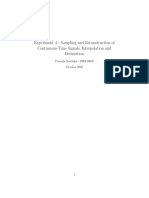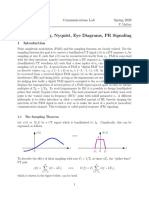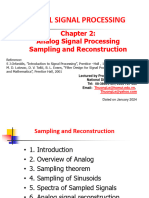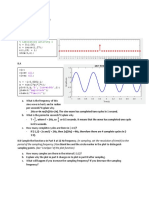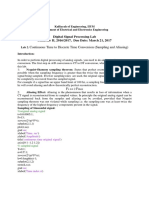0% found this document useful (0 votes)
82 views5 pagesDigital Signal Processing Lab Report
This document summarizes the results of an experiment on sampling and digital signal processing. It discusses (1) sampling a signal at frequencies above the Nyquist rate, where the spectrum becomes sharper as more samples are taken, (2) sampling below the Nyquist rate causes aliasing and loss of information, and (3) the spectrum of a square wave contains only odd harmonics as expected. It also (4) describes using zero interpolation and a low-pass filter to upsample a signal, which introduces a delay but results in a signal equivalent to sampling at a higher rate.
Uploaded by
Gautam SharmaCopyright
© © All Rights Reserved
We take content rights seriously. If you suspect this is your content, claim it here.
Available Formats
Download as PDF, TXT or read online on Scribd
0% found this document useful (0 votes)
82 views5 pagesDigital Signal Processing Lab Report
This document summarizes the results of an experiment on sampling and digital signal processing. It discusses (1) sampling a signal at frequencies above the Nyquist rate, where the spectrum becomes sharper as more samples are taken, (2) sampling below the Nyquist rate causes aliasing and loss of information, and (3) the spectrum of a square wave contains only odd harmonics as expected. It also (4) describes using zero interpolation and a low-pass filter to upsample a signal, which introduces a delay but results in a signal equivalent to sampling at a higher rate.
Uploaded by
Gautam SharmaCopyright
© © All Rights Reserved
We take content rights seriously. If you suspect this is your content, claim it here.
Available Formats
Download as PDF, TXT or read online on Scribd
/ 5
























